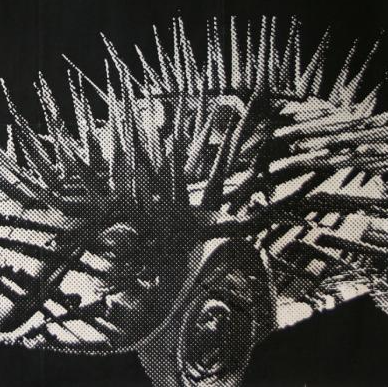Dust Devil
'A Terror Too Exquisite to Resist', or something. Actually, that's a different film with that tagline.

UK poster | Polygram Filmed Entertainment
1992 — UK / USA
A PALACE production, presented by PALACE and FILM FOUR INTERNATIONAL in association with MIRAMAX FILM CORP. and with the participation of BRITISH SCREEN; completed by the SHADOW THEATRE
Cast: ROBERT BURKE and CHELSEA FIELD, with ZAKES MOKAE, JOHN MATSHIKIZA, RUFUS SWART, WILLIAM HOOTKINS and MARIANNE SÄGEBRECHT
Written and Directed by: RICHARD STANLEY
Produced by: JOANNE SELLAR
Executive Producers: NIK POWELL, STEPHEN WOOLLEY and PAUL TRYBITS
Associate Producers: BOB WEINSTEIN and HARVEY WEINSTEIN
Editing: DEREK TRIGG; 'Final Cut' editing by PAUL CARLIN
Cinematography: STEVEN CHIVERS
Production design: JOSEPH BENNETT
Costume design: MICHELE CLAPTON
Special makeup effects and Animatronics: THE DREAM MACHINE
Music: SIMON BOSWELL
© Palace (Devil) Ltd.
Rights reserved by Shadow Theatre Films
There are myriad cuts of this film (I talk about it a bit below), but this text is largely based on the 1993 'Final' cut, which honestly is probably the easiest one to acquire in the UK anyway.
Dust Devil is Richard Stanley’s second feature after the officially unofficial, or maybe the other way around, 2000 AD film, Hardware.* It was also one of the last films to be produced by Palace Pictures; it, along with The Crying Game (1992), was being prepped when the company shut up shop, leaving it in an awkward limbo. In the UK, it apparently had a cinema run of but a week, with the BBFC only logging it as having had home video ratings in their big online catalogue of decisions. That’s not really fool proof as evidence goes; I’ve written previously about some films that aren’t listed but that they clearly have rated; but the UK poster for the film I found is conspicuously missing an age rating. Maybe Polygram (who ostensibly picked up Palace’s slack) weren’t even considering it for wide release?
Well, anyway, the town of Bethany is on the border of Namibia and South Africa.** Ravaged by drought and the tensions between South Africa and ‘South West Africa’, the town is dying. Passing through the deserts surrounding this town is a hitchhiker (Robert Burke). This man, suffice to say, is not on the up; proceeding to commit ritual slaughter of his drivers before parting ways, as you do. Despite this, there’s little in the way of clues as to who he is. The locals speculate that the killer is not human, much to the chagrin of the officer leading the investigation (Zakes Mokae). Meanwhile, Jo’burg housewife Wendy (Chelsea Field) has left her husband (Rufus Swart), driving aimlessly with the vague goal of reaching the sea, which seems like it would be a lot quicker if she went in the other direction. On this road trip, she, natch, picks up the hitcher (probably not to be confused with The Hitcher)… she soon starts to notice preternatural events seem to be surrounding them.
So… Dust Devil had a difficult journey to the screen. Even beyond the stuff mentioned in the first paragraph, it seemed to be plagued with post-production issues and disagreements, resulting in there being several cuts of the thing floating about the place. As tended to be the Weinsteins’ wont, they excised nearly a half hour of footage from the work print, reportedly making the film nigh on incomprehensible, and redubbed the thing. This would seemingly kind of put paid to the idea of Harvey Weinstein’s claim that his infamously scissor happy approach was “for the shit to work”, as well as that weird myth that for all that whole rape and assault and abuse stuff he was a great producer. (The Weinsteins’ success at the Oscars more seems to be down to knowing how to play the Academy’s game; Miramax is to blame, for instance, for the rather distasteful focus on the sex of The Crying Game’s heroine as some kind of cheap shock. The film’s reveal is far from tactful in its execution, especially considering its broadly sympathetic approach to the subject matter (particularly for the time), but Miramax succeeded in making it all about the reveal and caused the film to get lumped in with the standard trans panic media that saw a revival post Silence of the Lambs (1991). I have legitimately seen people list it alongside things like Dressed to Kill (1980) and Silence of the Lambs as an example of trans psycho serial killer/slasher flicks that pervade the group's presentation in media, presumably based on this bit of marketing, which… no. (that’s not getting into Silence’s attempts to explicitly state that the killer is not a trans woman, which also tends to get lost in people's minds behind the more lurid stuff.)) That version did the rounds about America and bits of Europe, with various other incarnations of the thing cropping up elsewhere. The so-called ‘final cut’, which trims about 10 minutes from the workprint, eventually materialised a year or so later with Channel 4’s intervention; as original investors, Richard Stanley prevailed on them to intercede on his behalf in recovering the negatives, with them deciding they wanted to see an end result to their investment rather than having the film fester away in Polygram’s vault.
I suppose I’m talking a bit much about the circumstances and not enough about the film itself. I just find it interesting, but then I’m a sponge for this kind of crap.
Leaving aside Richard Stanley’s lucklessness in getting films made,*** the film is perhaps kind of an odd prospect. It mashes up myriad elements and genres with a bunch of of-its-time social commentary on the situation in late apartheid era South Africa and Namibia as well as a load of considerations on local myth and legend. Reportedly Miramax were pushing during production to make it more like Silence of the Lambs, though the actual product, at least the favoured cut, probably feels more comparable to Picnic at Hanging Rock (1975), weirdly enough… albeit with more sex and gore… what with its Fortean goings on as a bunch of white people get lost in the wilderness, straying from their oppressive colonial finery, itself something that shouldn’t be there, and finding a new world brimming with things that are fascinating and beautiful and dangerous and all that jazz, all executed at a slow, methodical pace. Dust Devil does more to explain itself than Hanging Rock does; the nature of the events surrounding the characters is explicitly stated, or at least what it theoretically happening, as there’s sufficient wiggle room to allow for the explanations provided to have some doubt. Is the supernatural actually afoot or is it just convenience to ascribe what’s going on to unknown forces? It’s curious to consider.
A curious effect of the film is that the more traditionally ‘real’ environs of the film, such as the police station or the suburbs, have an air of glossy falsehood that’s missing from the desert where the ‘magic’ happens. The colonial society has the look and feel of soap operas and cop shows which serve to highlight their constructed nature. Meanwhile the countryside has gorgeous though desolate vistas, punctuated with the odd sign of deserted life, before eventually hitting on a ghost town in time for the climax. The further away from normality the story drifts, the more real everything feels.
The film’s cult status is probably bolstered by the troubled production and its long-term unavailability; the director’s cut didn’t see the light of day in America until 2006. That’s not to say that it doesn’t deserve to be looked upon fondly. While it pilfers a lot of elements as part of its genre mash-up; grabbing as it does bits of westerns, thrillers and horror movies, including a rather early ‘90s bout of dreams divulging clues to the crimes at hand, together with existentialist ramblings; it’s hardly the only film of the era to do that, and what’s more it does manage to arrange them in a way that makes for something unique, compelling, haunting and often beautiful.
* Hardware was inspired (possibly in quotes; I haven’t seen the film so I can’t really say how suspiciously similar it is) by a Judge Dredd adjacent story, ‘Shok!’, from 1981. It originally made no mention of this, and erstwhile 2000 AD publisher Fleetway successfully sued after the film’s release due to not authorising an adaptation; later prints include credits declaring it an adaptation of the story. I guess there weren’t that many hard feelings on the magazine’s part; Stanley was apparently amongst the directors offered the long gestating Judge Dredd (1995), which one assumes wouldn’t have happened if they were that upset.
** Not to be confused with the actual town of Bethanie in southern Namibia.
*** This was followed up by a film version of a Marillion concept album that he apparently lost control of and largely disowned, but both seem like a cakewalk compared to his ill-fated version of
The Island of Dr. Moreau. He didn’t direct another non-documentary feature for over twenty years.
At time of writing, Dust Devil isn't even listed on JustWatch and doesn't appear to be on any major streaming service. Sorry, kids. Alternatively, physical copies are reportedly available for rent via Cinema Paradiso.
The film presently has a 15 rating (last submitted in 2006), the BBFC citing “strong bloody horror and strong language”.
Sources
Epstein, D.R., 2006. Suicide Girls – Dust Devil director Richard Stanley, [online]. Available at: <https://web.archive.org/web/20111005023454/http://www.everythingisundercontrol.org/nagtloper/iviews/scdgrl.php> [Accessed 22 February 2021]. Archived from the original.
Flower, J., 2007. Dust Devil: Demoniaca vs. The Final Cut – Behind the Miramax cut of Dust Devil, [online]. Available at: <https://web.archive.org/web/20111005031246/http://www.everythingisundercontrol.org/nagtloper/ddevil/dd_demon.php> [Accessed 23 February 2021]. Archived from the original.
Gregorits, G., 2001. Total Abuse – Richard Stanley and the Devil, [online]. Available at: <https://web.archive.org/web/20111005023802/http://www.everythingisundercontrol.org/nagtloper/iviews/sng.php> [Accessed 22 February 2021]. Archived from the original.
Mayne, L., 2016. Richard Stanley's 'Dust Devil' and the changing face of Film4, [online]. Available at: <http://wearecult.rocks/richard-stanleys-dust-devil-and-the-changing-face-of-film4> [Accessed 20 February 2021].
Between Death and the Devil, 2007?. Dust Devil – Behind the Scenes, [online]. Available at: <https://web.archive.org/web/20111005031450/http://www.everythingisundercontrol.org/nagtloper/ddevil/ddevil2.php> [Accessed 22 February 2021]. Archived from the original.



